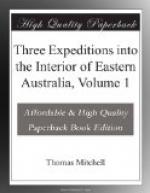February 23.
This morning we were early en route in hopes to reach the Namoi. I took care to find again the tree which bore the yellow flowers; as it certainly was rare, being the only one of the description seen throughout the journey. Now however the flowers had given place to young fruit which were of the size of an acorn, and grew on a long hooked stalk.*
(Footnote. See Chapter 2.8 of next Journey for a description of this tree.)
In crossing the low ridge which separates the plains from the Namoi we again toiled through very soft ground. It occurred chiefly on the sides of slopes, and in the midst of forests of eucalypti, where I should have expected the hardest kind of surface. We made the Namoi however in good time; this being the first of our former stages which we had been able to accomplish in one day since the wet weather commenced. The late rains had produced no change in the waters of this river; a circumstance showing perhaps that less had fallen in the south-east than on the plains where we had been.
None of the kind of fish that we most prized (Gristes peelii) could now be caught in this river, though abundance of that which the men commonly called bream (Cernua bidyana) a very coarse but firm fish which makes a groaning noise when taken out of the water; and here it may be observed that the colour of the cod or Peel’s perch was lighter, and that of the eel-fish (tandanus) darker in the Karaula than in any other river.
REGAIN THE NAMOI.
February 24.
A fine cool morning. I attempted to cut off a slight detour in our old track by travelling nearer to the course of the Namoi; but a soft and swampy flat soon compelled me to seek the former wheel-marks, and even to proceed still nearer to the base of the hills, for the sake of hard ground. We next travelled westward of our line, thus crossing an excellent tract of country; and without further impediment we arrived on Maule’s creek, which we crossed with all our carts and equipment to encamp on the left bank. The limpid stream was not much, if at all, augmented.
From this side of the country, now that smoke no longer obscured the horizon, the outline of the great range was very bold, a lofty and very prominent pyramid crowning the most elevated south-western extremity, and forming as important a point for the survey of the country to the south-west as Mount Riddell presents for that towards the north-west. This point I named Mount Forbes after my friend Captain Forbes, 39th Regiment, then commanding the mounted police in New South Wales. That great range presents three principal heads, of which Mounts Riddell and Forbes are the northern and southern, the central or highest being Mount Lindesay.
February 25.




